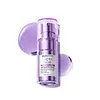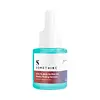What's inside
What's inside
 Key Ingredients
Key Ingredients

 Benefits
Benefits

 Concerns
Concerns

 Ingredients Side-by-side
Ingredients Side-by-side

Water
Skin ConditioningGlycerin
HumectantLactic Acid
BufferingButylene Glycol
HumectantGluconolactone
Skin ConditioningPropylene Glycol
HumectantPropanediol
SolventSodium Hydroxide
BufferingAlbizia Julibrissin Bark Extract
MaskingSuccinic Acid
BufferingHydrolyzed Collagen
EmollientEnantia Chlorantha Bark Extract
Skin ConditioningCitrus Paradisi Fruit Extract
Skin ConditioningXanthan Gum
EmulsifyingHydroxyacetophenone
AntioxidantSalicylic Acid
MaskingLactobionic Acid
BufferingMandelic Acid
AntimicrobialHydroxycinnamic Acid
Skin ConditioningRutin
AntioxidantGlycerophosphoinositol Choline
Skin ProtectingNiacinamide
SmoothingAlpha-Arbutin
Antioxidant1,2-Hexanediol
Skin ConditioningPEG-40 Hydrogenated Castor Oil
EmulsifyingAcrylamide/Sodium Acryloyldimethyltaurate Copolymer
Emulsion StabilisingAmmonium Sulfate
Sodium Sulfate
Citric Acid
BufferingAmylopectin
Ethylhexylglycerin
Skin ConditioningOleanolic Acid
Skin ConditioningDextrin
AbsorbentPhenoxyethanol
PreservativeSodium Benzoate
MaskingAroma
CI 16035
Cosmetic ColorantCI 60730
Cosmetic ColorantWater, Glycerin, Lactic Acid, Butylene Glycol, Gluconolactone, Propylene Glycol, Propanediol, Sodium Hydroxide, Albizia Julibrissin Bark Extract, Succinic Acid, Hydrolyzed Collagen, Enantia Chlorantha Bark Extract, Citrus Paradisi Fruit Extract, Xanthan Gum, Hydroxyacetophenone, Salicylic Acid, Lactobionic Acid, Mandelic Acid, Hydroxycinnamic Acid, Rutin, Glycerophosphoinositol Choline, Niacinamide, Alpha-Arbutin, 1,2-Hexanediol, PEG-40 Hydrogenated Castor Oil, Acrylamide/Sodium Acryloyldimethyltaurate Copolymer, Ammonium Sulfate, Sodium Sulfate, Citric Acid, Amylopectin, Ethylhexylglycerin, Oleanolic Acid, Dextrin, Phenoxyethanol, Sodium Benzoate, Aroma, CI 16035, CI 60730
Water
Skin ConditioningArtemisia Vulgaris Extract
Skin ConditioningAloe Barbadensis Leaf Extract
EmollientGlycolic Acid
BufferingCalendula Officinalis Flower Extract
MaskingLactobionic Acid
BufferingSodium Hydroxide
BufferingPentylene Glycol
Skin ConditioningCocamidopropyl Dimethylamine
EmulsifyingGlycerin
HumectantSalicylic Acid
MaskingPropanediol
Solvent1,2-Hexanediol
Skin ConditioningPanthenol
Skin ConditioningButylene Glycol
HumectantXanthan Gum
EmulsifyingC12-14 Pareth-12
EmulsifyingBetaine
HumectantCaprylyl Glycol
EmollientMelia Azadirachta Leaf Extract
Skin ConditioningEthylhexylglycerin
Skin ConditioningMelia Azadirachta Flower Extract
Skin ConditioningAnthemis Nobilis Flower Extract
MaskingAmino Esters-1
Skin ConditioningCoccinia Indica Fruit Extract
Skin ConditioningSolanum Melongena Fruit Extract
Skin ConditioningSodium Phytate
Aloe Barbadensis Flower Extract
EmollientOctanediol
Curcuma Longa Root Extract
MaskingOcimum Basilicum Flower/Leaf Extract
TonicPearl Powder
Lawsonia Inermis Flower/Fruit/Leaf Extract
MaskingOcimum Sanctum Leaf Extract
Skin ConditioningAllantoin
Skin ConditioningCaffeine
Skin ConditioningTocopherol
AntioxidantWater, Artemisia Vulgaris Extract, Aloe Barbadensis Leaf Extract, Glycolic Acid, Calendula Officinalis Flower Extract, Lactobionic Acid, Sodium Hydroxide, Pentylene Glycol, Cocamidopropyl Dimethylamine, Glycerin, Salicylic Acid, Propanediol, 1,2-Hexanediol, Panthenol, Butylene Glycol, Xanthan Gum, C12-14 Pareth-12, Betaine, Caprylyl Glycol, Melia Azadirachta Leaf Extract, Ethylhexylglycerin, Melia Azadirachta Flower Extract, Anthemis Nobilis Flower Extract, Amino Esters-1, Coccinia Indica Fruit Extract, Solanum Melongena Fruit Extract, Sodium Phytate, Aloe Barbadensis Flower Extract, Octanediol, Curcuma Longa Root Extract, Ocimum Basilicum Flower/Leaf Extract, Pearl Powder, Lawsonia Inermis Flower/Fruit/Leaf Extract, Ocimum Sanctum Leaf Extract, Allantoin, Caffeine, Tocopherol
Ingredients Explained
These ingredients are found in both products.
Ingredients higher up in an ingredient list are typically present in a larger amount.
1,2-Hexanediol is a synthetic liquid and another multi-functional powerhouse.
It is a:
- Humectant, drawing moisture into the skin
- Emollient, helping to soften skin
- Solvent, dispersing and stabilizing formulas
- Preservative booster, enhancing the antimicrobial activity of other preservatives
Butylene Glycol (or BG) is used within cosmetic products for a few different reasons:
Overall, Butylene Glycol is a safe and well-rounded ingredient that works well with other ingredients.
Though this ingredient works well with most skin types, some people with sensitive skin may experience a reaction such as allergic rashes, closed comedones, or itchiness.
Learn more about Butylene GlycolEthylhexylglycerin (we can't pronounce this either) is commonly used as a preservative and skin softener. It is derived from glyceryl.
You might see Ethylhexylglycerin often paired with other preservatives such as phenoxyethanol. Ethylhexylglycerin has been found to increase the effectiveness of these other preservatives.
Glycerin is already naturally found in your skin. It helps moisturize and protect your skin.
A study from 2016 found glycerin to be more effective as a humectant than AHAs and hyaluronic acid.
As a humectant, it helps the skin stay hydrated by pulling moisture to your skin. The low molecular weight of glycerin allows it to pull moisture into the deeper layers of your skin.
Hydrated skin improves your skin barrier; Your skin barrier helps protect against irritants and bacteria.
Glycerin has also been found to have antimicrobial and antiviral properties. Due to these properties, glycerin is often used in wound and burn treatments.
In cosmetics, glycerin is usually derived from plants such as soybean or palm. However, it can also be sourced from animals, such as tallow or animal fat.
This ingredient is organic, colorless, odorless, and non-toxic.
Glycerin is the name for this ingredient in American English. British English uses Glycerol/Glycerine.
Learn more about GlycerinLactobionic Acid is a PHA. PHAs are the gentle cousins to AHAS.
Like AHAs, they exfoliate the top layer of skin. Lactobionic acid also exhibits significant antioxidant activity.
PHAs are more gentle than AHAs due to their larger structure. This means they do not penetrate as deeply as AHAs and take a longer time to dissolve dead cells. Studies show PHAs do not cause as much irritation.
By removing dead skin cells, PHAs leave the skin brighter and with even-texture.
Learn more about Lactobionic AcidPropanediol is an all-star ingredient. It softens, hydrates, and smooths the skin.
It’s often used to:
Propanediol is not likely to cause sensitivity and considered safe to use. It is derived from corn or petroleum with a clear color and no scent.
Learn more about PropanediolSalicylic Acid (also known as beta hydroxy acid or BHA) is a well-known ingredient for treating skin that struggles with acne and clogged pores. It exfoliates both the skin's surface and deep within the pores to help clear out buildup, control oil, and reduce inflammation.
Unlike AHAs (alpha hydroxy acids), salicylic acid is oil-soluble. This allows it to penetrate into pores which makes it especially effective for treating blackheads and preventing future breakouts.
Salicylic acid is also known for its soothing properties. It has a similar structure to aspirin and can calm inflamed or irritated skin, making it a good option for acne-prone skin that is also sensitive.
Concentrations of 0.5-2% are recognized by the U.S. FDA as an over-the-counter topical acne product.
It can cause irritation and/or dryness if one's skin already has a compromised moisture barrier, so it's best to focus on repairing that before introducing this ingredient into your routine.
While salicylic acid does not increase sun sensitivity, it’s still important to wear sunscreen daily to protect your skin.
If you are looking for the ingredient called BHA or Butylated Hydroxyanisole, click here.
Learn more about Salicylic AcidSodium Hydroxide is also known as lye or caustic soda. It is used to adjust the pH of products; many ingredients require a specific pH to be effective.
In small amounts, sodium hydroxide is considered safe to use. However, large amounts may cause chemical burns due to its high alkaline.
Your skin has a natural pH and acid mantle. This acid mantle helps prevent harmful bacteria from breaking through. The acid mantle also helps keep your skin hydrated.
"Alkaline" refers to a high pH level. A low pH level would be considered acidic.
Learn more about Sodium HydroxideWater. It's the most common cosmetic ingredient of all. You'll usually see it at the top of ingredient lists, meaning that it makes up the largest part of the product.
So why is it so popular? Water most often acts as a solvent - this means that it helps dissolve other ingredients into the formulation.
You'll also recognize water as that liquid we all need to stay alive. If you see this, drink a glass of water. Stay hydrated!
Learn more about WaterXanthan gum is used as a stabilizer and thickener within cosmetic products. It helps give products a sticky, thick feeling - preventing them from being too runny.
On the technical side of things, xanthan gum is a polysaccharide - a combination consisting of multiple sugar molecules bonded together.
Xanthan gum is a pretty common and great ingredient. It is a natural, non-toxic, non-irritating ingredient that is also commonly used in food products.
Learn more about Xanthan Gum